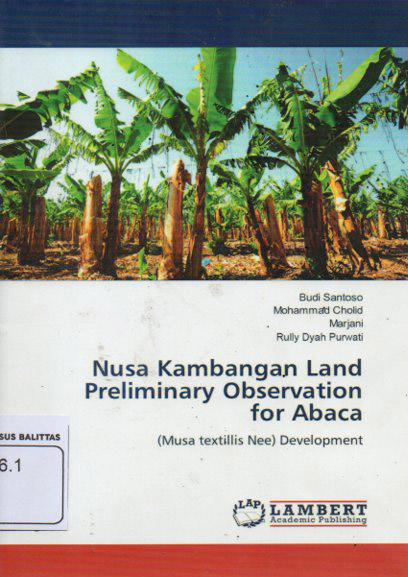|
500
|
#
|
#
|
$a Abaca (Musa textilis Nee) is an environmentally friendly plant that produces natural fiber. On that basis it is not surprising if abaca favored by entrepreneurs in industrial field. Several uses of abaca fiber are as pulp raw material, especially for security paper, paper documents such as postage stamps, stamp duty, certificate, check and money (Santoso and
Purwati, 2011). Abaca can also be used for cable wrap, car interiors, dashboard, doortrim, and spare tire cover (Lay and Heliyanto). Natural fibers competitors are synthetic fibers that generally difficult to recycle such as glass fiber and carbon fiber. Countries that promote human civilization such as America, Japan, England, Netherlands, Germany and
Europe still love an environmentally friendly fiber that has local wisdom which is renewable and sustainable. Currently the need for abaca fiber continues to grow from year to year. This shows that abaca fiber have advantages compared to other natural fibers. Indonesia as an agricultural country, which in fact can generate income through its natural resources,
has a fertility rate as well as an appropriate climate for abaca growth. The plantation sector is the country's largest foreign exchange earner after oil and mining. Abaca provides a promising hope for entrepreneurs if done carefully and truly. From abaca farming analysis system, based on B / C ratio, it turns out that the value is more than 1, meaning that abaca
business has nothing to lose. Today, abaca cultivation technology are already exists, and has been developed by Indonesian Agency for Agricultural Research and Development. An abaca superior varieties with high yield, is the main capital in improving abaca fiber production. The world's largest abaca fiber producer is Philippina and Ecuador
(Anonymous, 2010). All of the world's needs for abaca fiber are now available from both countries, but the situation does not go smoothly with the frequent moro rebellions in Mindanao, and the ISIS in Marawi, Philipines. While Ecuador often experience climate disturbance, thus experiencing barriers in abaca fiberproduction. Joko Widodo's government
is currently encouraging the plantation sector development by facilitating
permit land use for investors. Land clearing for agricultural use especially
abaca are expected to support the business world development and
strengthen the existence of natural resource, as well as increases the
country's foreign exchange and reduce the dependencies on fiber imports.
At present, there are only 1 abaca plantations in Indonesia, managed by
PT. Banyu Lor on Raung mountain slopes, Banyuwangi, with planted
abaca land about 300 hectares. While the people who planted abaca is in
Sangir Talahut located in northern Sulawesi bordering Philipinna. It is
estimated that the abaca planted in Sangir Talaut are from Philippines. It
can be seen that the abaca varieties of Sangir Talaut resemble the abaca
cultivated in Philippines.
|
